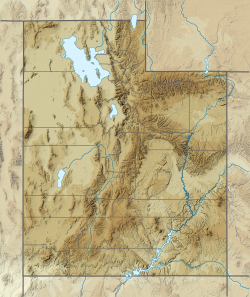Top Qs
Timeline
Chat
Perspective
Altar of Sacrifice
Sandstone mountain in the state of Utah From Wikipedia, the free encyclopedia
Remove ads
Altar of Sacrifice is a 7,505-foot (2,288 m) Navajo Sandstone mountain in Zion National Park in Washington County, Utah, United States,[3] that is part of the Towers of the Virgin.
Remove ads
Description
Altar of Sacrifice is situated 2.5 mi (4.0 km) west-northwest of Zion's park headquarters, towering 3,500 feet (1,100 m) above the floor of Zion Canyon and the Virgin River which drains precipitation runoff from this mountain. Its nearest higher neighbor is The West Temple, one mile (1.6 km) to the south.[1] Other neighbors include The Witch Head, Meridian Tower, Bee Hive, The Sentinel, Mount Spry, Bridge Mountain, and Mount Kinesava.
Remove ads
Etymology and naming
Altar of Sacrifice, The Great White Throne, and Angels Landing were named by Methodist Minister Frederick Vining Fisher from Ogden during a visit to Zion Canyon in 1916.[4] This feature's name gained its appropriateness from dark red stains caused by hematite (iron oxide) that appear on the face of the east wall, as though great quantities of blood had been spilled from the top.[3] Altar of Sacrifice's name was officially adopted in 1934 by the U.S. Board on Geographic Names.[3]
Remove ads
Climate
Spring and fall are the most favorable seasons to visit Altar of Sacrifice. According to the Köppen climate classification system, it is located in a Cold semi-arid climate zone, which is defined by the coldest month having an average mean temperature below 32 °F (0 °C), and at least 50% of the total annual precipitation being received during the spring and summer. This desert climate receives less than 10 inches (250 millimeters) of annual rainfall, and snowfall is generally light during the winter.[5]
Gallery
See also
References
External links
Wikiwand - on
Seamless Wikipedia browsing. On steroids.
Remove ads











